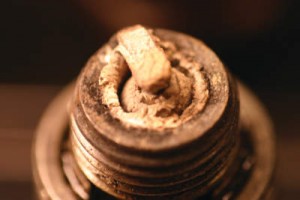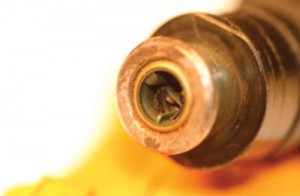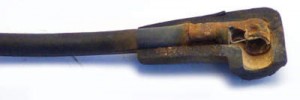A flashing check engine light and a P0301 to P0312 diagnostic trouble code (DTC) is a surefire indication that one or more cylinders are misfiring. Occasional misfires may pass unnoticed, but a steady misfire is hard to miss. The engine usually feels rough, lacks power and uses more gas than usual. Sometimes a misfire may feel like a vibration. A misfire also will cause a huge increase in hydrocarbon (HC) emissions, which can cause a vehicle to fail an emissions test.
Misfires that turn on the check engine light and log a cylinder-specific fault code are the easiest to diagnose. The OBD II system will identify the cylinder(s) that are not contributing their normal dose of power and set a code that corresponds to the firing order. A P0303 code, for example, would tell you that the No. 3 cylinder is misfiring. To figure out which cylinder is No. 3, refer to a diagram of the engine’s firing order or look for markings on the intake manifold, spark plug wires or ignition coils (if the engine has a coil-on-plug ignition system).
When you have a misfire code for a particular cylinder, you can focus on one of three things: an ignition problem, a fuel injector problem or a compression problem.
 Worn Spark Plugs
Worn Spark Plugs
Every time a spark plug fires, the spark burns a few molecules of metal off the plug’s electrodes. Over time, this eats away the electrodes and rounds off their sharp edges. The erosion gradually increases the gap between the electrodes, which, in turn, increases the firing voltage required to generate a spark. Eventually the ignition system reaches a point where it fails to produce enough voltage and the plug misfires.
Bad Spark Plug Wires
Bad spark plug wires are another common cause of misfires. After 50,000 miles or so, OEM carbon-core ignition wires develop too much internal resistance, which weakens the spark and increases the risk of misfire. High-mileage plug wires also can develop cracks that leak current to ground or to other wires, shorting the spark before it can reach the plug. Inspect the wires closely and measure their resistance. Replace any wires that are worn, damaged, do not fit properly or have resistance that exceeds specifications. If more than one plug wire is bad, replace the entire set.
Weak Fuel Injector
A condition known as “lean misfire” can occur if there is not enough fuel in the combustion chamber. Lean misfire causes that only affect one cylinder include a dirty fuel injector, an open or shorted fuel injector, or a problem in the fuel injector driver circuit (wiring or PCM). Compression problems that may cause a misfire include a burned exhaust valve, bent intake or exhaust valve, or leaky head gasket.
 Leaking Fuel Injector
Leaking Fuel Injector
An individual cylinder with a rich fuel mixture is not as common as a lean mixture, but it can occur if the fuel injector leaks.
A more common condition would be a rich mixture in all cylinders caused by 1) a dead oxygen or coolant sensor that prevents the computer from going into a closed loop, 2) or a faulty fuel pressure regulator or plugged fuel return line that is routing too much pressure to the injectors.
Something else to look at in the spark burn line is the amount of “hash” it contains. A good cylinder will show a relatively clean line with little hash. A lot of hash, on the other hand, is a product of an ignition or lean misfire.
Vacuum Leak
A vacuum leak into the intake port of the cylinder in question can cause a lack of fuel. Vacuum leaks on individual cylinders commonly occur around intake port gaskets or vacuum hose connections. Insufficient valve lash, a broken piston ring or a leaking cylinder head gasket can cause a partial loss of compression.
Worn Rings and Valve Seals
Spark plugs encrusted with oil ash indicate that oil might be leaking through worn valve stem seals or piston rings. If the piston head is washed clean around the edges or across the dome, the oil is washing around worn or stuck piston rings. If the piston is dry and the oil ash is primarily accumulated on one side of the spark plug, the oil is likely entering the cylinder through a worn valve stem seal or guide.
 Flash Over or Carbon Tracking
Flash Over or Carbon Tracking
The most common failure in COP ignitions is carbon tracking or “flash over” on the spark plug insulator. Although carbon tracking is usually caused by oil, dirt or moisture creating a path to ground over the spark plug insulator, a severely eroded spark plug electrode will increase firing voltages so much that the spark will seek the point of least resistance, which is either through the spark plug boot or down the insulator to the metal shell. If a carbon track is found on a spark plug, an identical track will be found inside the spark plug boot.
If the boot is serviced as a replacement part separate from the coil, the boots should be replaced at the same intervals as the spark plugs. If the boot is available only with the coil assembly, the spark plugs should be replaced at the recommended intervals and care should be taken not to contaminate the boot or insulator with dirt or oil.
No Voltage at the Coil
If battery voltage exists and a COP assembly is suspected of causing an intermittent cylinder misfire, the quickest diagnostic procedure is to switch the coil from cylinder to cylinder. If the misfire follows the suspected coil, the failure will lie with the coil rather than the spark plug or PCM’s coil driver. An individual coil driver in the PCM will rarely fail.














